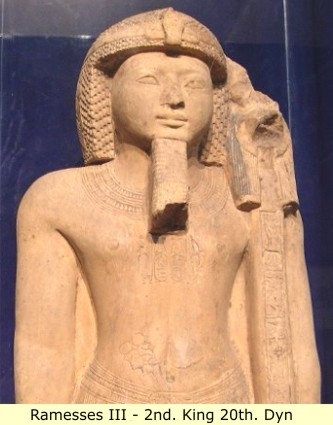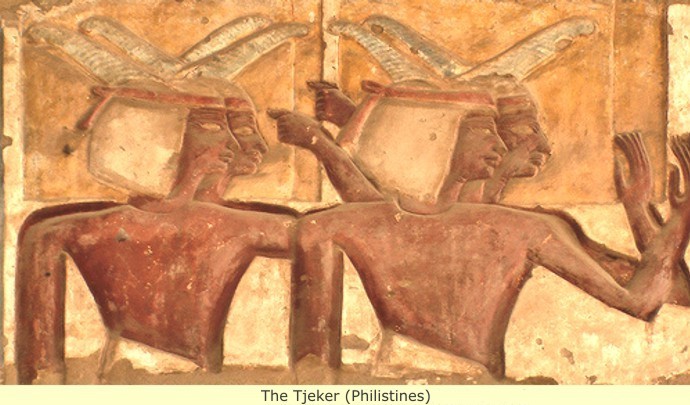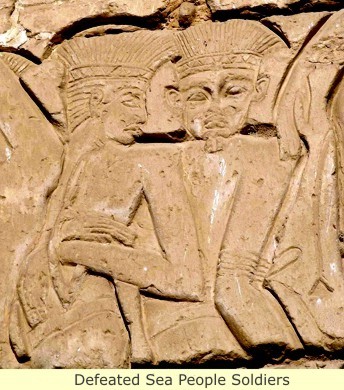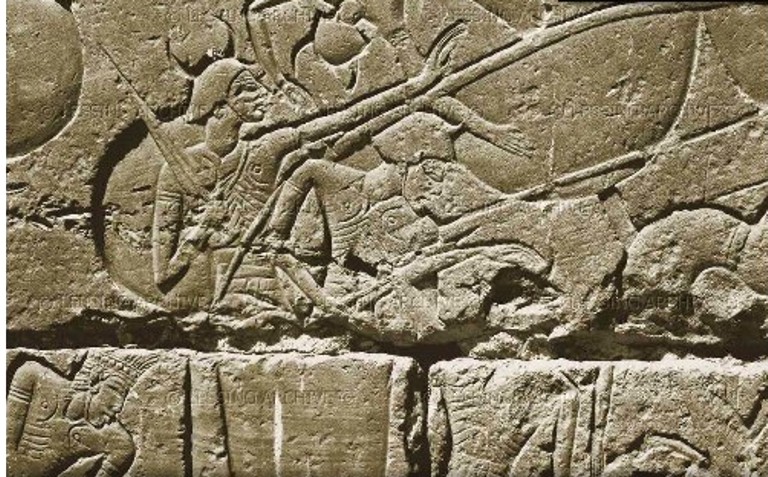I agree with the basic pillars of Immanuel Velikovsky’s Egyptian chronology (Middle Kingdom Exodus with the Hyksos invading some time after the Red Sea incident, Thuthmosis III as Shishak, El Amarna era during the divided Kingdom, Ramses II as Necho, Ramses III as Nectenbos of Diodorus with the Prstt being the Persian Empire and Sea Peoples as Ionian Greeks). I don’t agree with his weird theories about the planets though.
Rohl I don’t agree with on Egyptian chronology, but I like his identification of Enmerkar with Nimrod and Eridu with Babel and have written my own study on that subject.
I do want to discus some of the details of Velikovsky and his contemporary supporters’ model I disagree with.
On the Hyksos Amalekites connection which I’ve touched on elsewhere I just want to say I feel it’s not that simple. The Hyksos were many tribes of Asiatic peoples. They included the Amalekites and possibly other Edomite tribes (I think the king remembered by Greek myth as Belus was an Edomite King connected in some way to Bela son of Beor of Genesis 36:32&33), I think they had a Midianite aspect too (Hor II of the 13th Dynasty I think was the Midanite king Hur mentioned in The Bible). Archaeology clearly shows they had an Amorite aspect at all.
The most prominent is Hatshepsut as the Queen of Sheba. If she was an Egyptian queen The Bible wouldn’t have obscured that, it dealt with Solomon’s interactions with Egypt unambiguously both before and after this. Also since Tuthmosis I must be the Pharaoh who’s daughter Solomon married, Hatshepsut was her Sister. If this Queen was Solomon’s sister in law that wouldn’t been overlooked.
Yeshua calls her the “Queen of The South” in Matthew 12:42 and Luke 11:31. And then Daniel 11 is cited where the “King of The South” is consistently Egypt. South in Biblical geography is south of Israel/Jerusalem, in the context of Alexander’s successors only Ptolemy is south of Israel, and Egypt was the core of his Kingdom but not all of it.
There are three Shebas on the Table of Nations, Two in Genesis 10 and another being Abrahamic. The two in Genesis 10 are one Hamitic/Cushite and the other Semitic/Joktanite. But in both I Kings 10 and II Chronicles 11 the Queen of Sheba narrative is linked to Ophir another Joktanite name. And the other two Shebas are virtually inseparable from the Dedan who is their brother, but no Dedan is alluded to here.
Serious Archaeologists all know that Sheba was the name of a Kingdom in southern Arabia, modern Yemen. ( Israel Finkelstein, Neil Asher Silberman,David and Solomon: In Search of the Bible’s Sacred Kings and the Roots of the Western Tradition p. 167). The Saba that was a capital of Nubia/Ethiopia didn’t appears till very late, Meroë was their Capital until after the fall of the 25th Dynasty (When Nubia ruled Egypt). The Cushite Sheba of Genesis 10 I believe settled in Ancient India where he was deified as Shiva and his rather Ramaah as Rama an avatar of Vishnu.
I do believe the Ark of the Covenant came to Ethiopia. But the Menelik legend is propaganda created by the Christian Auxomite kings to give them a Biblical lineage. I believe Graham Hancock and Bob Cornuke’s theory for how it got there. First being at Elephantine island from sometime after King Manasseh’s reign of terror to the time of Cambyses.
The Arabic traditions of Balqis/Bilqis/Bilquis did exist in Pre-Islamic times (Mohammed didn’t really come up with much of anything new) and so have good reason to be viewed as more Ancient and Valid then the purely invented Ethiopian legend.
I do believe Hatshepsut probably visited Solomon also. The Bible says many rulers come to visit Solomon and witness his Wisdom. The Queen of Sheba is singled out NOT because she’s the most important by secular standards, but because she became a Saved individual, so Yeshua cited her as such.
So I do agree that Punt was an Egyptian name for Canaan/Israel. And I don’t think the similarity between Make-Ra (A name of Hatshepsut) and Makeda (The name of the Queen of Sheba in the Ethiopian traditions) is a coincidence. I think various Egytpian Jews, first at Elephantine and then latter in Alexandria and the Onias colony, drew the same false conclusion and began giving her that name. And this may have influenced Josephus who was very familiar with Alexandrian Jewish traditions.
El Amarna period.
I agree with Velikovsky’s on Jehoshaphat as Ebed-Tov/Abdi-Heba King of Jerusalem and Mesha King of Moab with the Mesh of the Amarna letters. The Amarna letters also lsit 3 of the Captains of Jehoshaphat from II Chronicles 17:14-19. Addudani/Addadani=Adna and Ada-danu mentioned by Shalmaneser in 825 BC, “Son of Zuchru” = “son of Zichri”, Iahzibada=Iehozabad/Jehozabad.
And I agree about the Habiru being bandits or mercenaries, not an ethnic term.
But his identity for Ahab is very problematic. Gubla is the Amarna letters name for Byblos not Jezreel. So Rib-Addi/Rib-Hadda was not Israelite.
Labaya I feel is logically is Ahab, (or whoever the Northern Kingdom ruler was at the time). The whole Jezebel-Nefertiti connection suggested by SpecialtyInterests I don’t like however.
Velikovsky’s references to “Sodomites” is really weird, he’s unaware that that is a reference to Sodom only in English.
Velikovsky did NOT believe in the infallibility of Scripture. Which of course is an assumption many critics of revised chronology make about all revised chronologists. This fact about him is most apparent in the part of Age sin Chaos about the Death of Ahab. He basis it on what he saw as a contradiction between this verse.
II Kings 1:17 “So he died according to the word of the LORD which Elijah had spoken. And Jehoram reigned in his stead in the second year of Jehoram the son of Jehoshaphat king of Judah; because he had no son.”
And these two verses.
II Kings 3:1 “Now Jehoram the son of Ahab began to reign over Israel in Samaria the eighteenth year of Jehoshaphat king of Judah, and reigned twelve years.”
II Kings 8:16 “And in the fifth year of Joram the son of Ahab king of Israel, Jehoshaphat being then king of Judah, Jehoram the son of Jehoshaphat king of Judah began to reign.”
There is no contradiction here however, he’d know this if he’d studied Ussher’s chronology. Jehoshaphat made his son a co ruler for the latter years of his reign, this is why the 18th year of Jehoshaphat can also be the second year of Jehoram.
As for the fact that Ahab did Repent after Elijah rebuked him over the Naboth business. That was negated when Ahab sinned again believing the False Prophets over Micaiah.
But Velikovsky creates a whole convoluted theory that Ahab survived the battle of Ramoth-Gilead and lived another 9 years.
Mesha of Moab’s rebellion was right after Israel’s defeat at Ramoth-Gilead, Velikovsky sees the Moabite stone documenting this event as saying it was in the Middle of Ahab’s reign, not after he died. First off the stone sounds like he’s relating a Prophesy made by a Prophet of Chemosh, who’s Prophecy may have came true not not completely accurately. But also if it was made immediately at the start of the rebellion he may not have heard of Ahab’s death yet.
Regardless of those arguments, not all readings of the Mesha Stele even agree with the one Velikovsky used to support his theory.
The Denyen of the Greek Islands
I said I agreed about the Prstt being the Persian Empire and Sea Peoples as Ionian Greeks. But his Identity of the “Peoples of the Islands” the Denyen as Athens I think is silly. The Denyen are also in the Amarna letters where they are in northern Syria, very northern, by the modern Turkish border. Associated with Hammath. Their also identified with Adana is Cilicia.
“And of Dan he said, Dan is a lion’s whelp: he shall leap from Bashan.” Deuteronomy 33:22
The Tribe of Dan originally settled north of the Philistine Lands, around the port city of Joppa/Jaffa modern Tel-Aviv. The books of Joshua and Judges both record events when Danites left their allotted land traveled north conquered a city and renamed it Dan.
“And the coast of the children of Dan went out too little for them: therefore the children of Dan went up to fight against Leshem, and took it, and smote it with the edge of the sword, and possessed it, and dwelt therein, and called Leshem, Dan, after the name of Dan their father.” Joshua 19:47
The Judges 18 account, where the City is Laish, is often assumed to be the same event. There are however several differences between the two accounts:
1. In the Book of Joshua the children of Dan had received an inheritance in the south but it was insufficient for them and so they went to fight against Leshem. In Judges though the Danites were in the region of Zorah and Eshtaol (in the south) they had yet not taken possession of their own.
2. In Judges, at least at first, only six hundred went forth after receiving the report of a reconnoitering mission: on the other hand, the Book of Joshua may be understood to say that all (or nearly all) of Dan went to fight.
3. In the Book of Joshua the city taken is called Leshem: In Judges the city is called LAISH. Some Commentators have tried to state that “Leshem” and “Laish” are different forms of the same word but “leshem” in Hebrew is a type of precious stone (maybe amber) while “laish” means a young male lion.
The Joshua account refers to the Dan that is frequently used as an idiom of the Northern Border of the Kingdom, where Jeroboam built one of his Idols, and which on the map of modern Israel is in the Golan heights on the Syrian border.
The Judges event is clearly much further north. They encountered Sidonians, but those Sidonians are also implied to be far from home. Laish is also know as Luash and the Danites who migrated there became known as Dananu.
The king of Sma’al in the valley north of ASI (Orontes embouchemont) on the edge of LUASH (LIASH) called himself “KING of the DANIM” i.e. of the Danes of Dan. The Danes (Dananu) also controlled the neighbouring area of Cilicia and at one stage their capital was Adana by Tarsis of Cilicia and their suzerainity reached as far north as Karatepe. A bi-lingual inscription of theirs found at Karatepe employs a Phoenician type of Hebrew and a version of Hittite. Branches of the Hittites in Anatolia neighboured the Dananu of Cilicia. This northern portion of Dan is referred to variously as Dananu, Danau, Denye, Denyen, Danuna.
Above I’ve borrowed a great deal from Britam’s “Dan and the Serpent Way” study. I don’t agree with all of Britam’s premise obviously, or any other form of British Israelism, but Dan does have a unique history.
Secular scholars agree on connecting the Denyen to the Tribe of Dan, you can read about it on Wikipedia’s Denyen and Dan pages. But the sequence is reverses, they believe the Denyen traveled south. This supports their attempts to claim that the various Tribes of Israel didn’t even really have a common origin. Traditional chronology makes that argument easy for them but still doesn’t make the Biblical picture impossible. But revised chronology makes it indisputable which Dan came first.
The connection they have to Greece, and the Danoi of Greek mythology is Biblically alluded to in Ezekiel 27.
I do want to discus some of the details of Velikovsky and his contemporary supporters’ model I disagree with.
On the Hyksos Amalekites connection which I’ve touched on elsewhere I just want to say I feel it’s not that simple. The Hyksos were many tribes of Asiatic peoples. They included the Amalekites and possibly other Edomite tribes (I think the king remembered by Greek myth as Belus was an Edomite King connected in some way to Bela son of Beor of Genesis 36:32&33), I think they had a Midianite aspect too (Hor II of the 13th Dynasty I think was the Midanite king Hur mentioned in The Bible). Archaeology clearly shows they had an Amorite aspect at all.
The most prominent is Hatshepsut as the Queen of Sheba. If she was an Egyptian queen The Bible wouldn’t have obscured that, it dealt with Solomon’s interactions with Egypt unambiguously both before and after this. Also since Tuthmosis I must be the Pharaoh who’s daughter Solomon married, Hatshepsut was her Sister. If this Queen was Solomon’s sister in law that wouldn’t been overlooked.
Yeshua calls her the “Queen of The South” in Matthew 12:42 and Luke 11:31. And then Daniel 11 is cited where the “King of The South” is consistently Egypt. South in Biblical geography is south of Israel/Jerusalem, in the context of Alexander’s successors only Ptolemy is south of Israel, and Egypt was the core of his Kingdom but not all of it.
There are three Shebas on the Table of Nations, Two in Genesis 10 and another being Abrahamic. The two in Genesis 10 are one Hamitic/Cushite and the other Semitic/Joktanite. But in both I Kings 10 and II Chronicles 11 the Queen of Sheba narrative is linked to Ophir another Joktanite name. And the other two Shebas are virtually inseparable from the Dedan who is their brother, but no Dedan is alluded to here.
Serious Archaeologists all know that Sheba was the name of a Kingdom in southern Arabia, modern Yemen. ( Israel Finkelstein, Neil Asher Silberman,David and Solomon: In Search of the Bible’s Sacred Kings and the Roots of the Western Tradition p. 167). The Saba that was a capital of Nubia/Ethiopia didn’t appears till very late, Meroë was their Capital until after the fall of the 25th Dynasty (When Nubia ruled Egypt). The Cushite Sheba of Genesis 10 I believe settled in Ancient India where he was deified as Shiva and his rather Ramaah as Rama an avatar of Vishnu.
I do believe the Ark of the Covenant came to Ethiopia. But the Menelik legend is propaganda created by the Christian Auxomite kings to give them a Biblical lineage. I believe Graham Hancock and Bob Cornuke’s theory for how it got there. First being at Elephantine island from sometime after King Manasseh’s reign of terror to the time of Cambyses.
The Arabic traditions of Balqis/Bilqis/Bilquis did exist in Pre-Islamic times (Mohammed didn’t really come up with much of anything new) and so have good reason to be viewed as more Ancient and Valid then the purely invented Ethiopian legend.
I do believe Hatshepsut probably visited Solomon also. The Bible says many rulers come to visit Solomon and witness his Wisdom. The Queen of Sheba is singled out NOT because she’s the most important by secular standards, but because she became a Saved individual, so Yeshua cited her as such.
So I do agree that Punt was an Egyptian name for Canaan/Israel. And I don’t think the similarity between Make-Ra (A name of Hatshepsut) and Makeda (The name of the Queen of Sheba in the Ethiopian traditions) is a coincidence. I think various Egytpian Jews, first at Elephantine and then latter in Alexandria and the Onias colony, drew the same false conclusion and began giving her that name. And this may have influenced Josephus who was very familiar with Alexandrian Jewish traditions.
El Amarna period.
I agree with Velikovsky’s on Jehoshaphat as Ebed-Tov/Abdi-Heba King of Jerusalem and Mesha King of Moab with the Mesh of the Amarna letters. The Amarna letters also lsit 3 of the Captains of Jehoshaphat from II Chronicles 17:14-19. Addudani/Addadani=Adna and Ada-danu mentioned by Shalmaneser in 825 BC, “Son of Zuchru” = “son of Zichri”, Iahzibada=Iehozabad/Jehozabad.
And I agree about the Habiru being bandits or mercenaries, not an ethnic term.
But his identity for Ahab is very problematic. Gubla is the Amarna letters name for Byblos not Jezreel. So Rib-Addi/Rib-Hadda was not Israelite.
Labaya I feel is logically is Ahab, (or whoever the Northern Kingdom ruler was at the time). The whole Jezebel-Nefertiti connection suggested by SpecialtyInterests I don’t like however.
Velikovsky’s references to “Sodomites” is really weird, he’s unaware that that is a reference to Sodom only in English.
Velikovsky did NOT believe in the infallibility of Scripture. Which of course is an assumption many critics of revised chronology make about all revised chronologists. This fact about him is most apparent in the part of Age sin Chaos about the Death of Ahab. He basis it on what he saw as a contradiction between this verse.
II Kings 1:17 “So he died according to the word of the LORD which Elijah had spoken. And Jehoram reigned in his stead in the second year of Jehoram the son of Jehoshaphat king of Judah; because he had no son.”
And these two verses.
II Kings 3:1 “Now Jehoram the son of Ahab began to reign over Israel in Samaria the eighteenth year of Jehoshaphat king of Judah, and reigned twelve years.”
II Kings 8:16 “And in the fifth year of Joram the son of Ahab king of Israel, Jehoshaphat being then king of Judah, Jehoram the son of Jehoshaphat king of Judah began to reign.”
There is no contradiction here however, he’d know this if he’d studied Ussher’s chronology. Jehoshaphat made his son a co ruler for the latter years of his reign, this is why the 18th year of Jehoshaphat can also be the second year of Jehoram.
As for the fact that Ahab did Repent after Elijah rebuked him over the Naboth business. That was negated when Ahab sinned again believing the False Prophets over Micaiah.
But Velikovsky creates a whole convoluted theory that Ahab survived the battle of Ramoth-Gilead and lived another 9 years.
Mesha of Moab’s rebellion was right after Israel’s defeat at Ramoth-Gilead, Velikovsky sees the Moabite stone documenting this event as saying it was in the Middle of Ahab’s reign, not after he died. First off the stone sounds like he’s relating a Prophesy made by a Prophet of Chemosh, who’s Prophecy may have came true not not completely accurately. But also if it was made immediately at the start of the rebellion he may not have heard of Ahab’s death yet.
Regardless of those arguments, not all readings of the Mesha Stele even agree with the one Velikovsky used to support his theory.
The Denyen of the Greek Islands
I said I agreed about the Prstt being the Persian Empire and Sea Peoples as Ionian Greeks. But his Identity of the “Peoples of the Islands” the Denyen as Athens I think is silly. The Denyen are also in the Amarna letters where they are in northern Syria, very northern, by the modern Turkish border. Associated with Hammath. Their also identified with Adana is Cilicia.
“And of Dan he said, Dan is a lion’s whelp: he shall leap from Bashan.” Deuteronomy 33:22
The Tribe of Dan originally settled north of the Philistine Lands, around the port city of Joppa/Jaffa modern Tel-Aviv. The books of Joshua and Judges both record events when Danites left their allotted land traveled north conquered a city and renamed it Dan.
“And the coast of the children of Dan went out too little for them: therefore the children of Dan went up to fight against Leshem, and took it, and smote it with the edge of the sword, and possessed it, and dwelt therein, and called Leshem, Dan, after the name of Dan their father.” Joshua 19:47
The Judges 18 account, where the City is Laish, is often assumed to be the same event. There are however several differences between the two accounts:
1. In the Book of Joshua the children of Dan had received an inheritance in the south but it was insufficient for them and so they went to fight against Leshem. In Judges though the Danites were in the region of Zorah and Eshtaol (in the south) they had yet not taken possession of their own.
2. In Judges, at least at first, only six hundred went forth after receiving the report of a reconnoitering mission: on the other hand, the Book of Joshua may be understood to say that all (or nearly all) of Dan went to fight.
3. In the Book of Joshua the city taken is called Leshem: In Judges the city is called LAISH. Some Commentators have tried to state that “Leshem” and “Laish” are different forms of the same word but “leshem” in Hebrew is a type of precious stone (maybe amber) while “laish” means a young male lion.
The Joshua account refers to the Dan that is frequently used as an idiom of the Northern Border of the Kingdom, where Jeroboam built one of his Idols, and which on the map of modern Israel is in the Golan heights on the Syrian border.
The Judges event is clearly much further north. They encountered Sidonians, but those Sidonians are also implied to be far from home. Laish is also know as Luash and the Danites who migrated there became known as Dananu.
The king of Sma’al in the valley north of ASI (Orontes embouchemont) on the edge of LUASH (LIASH) called himself “KING of the DANIM” i.e. of the Danes of Dan. The Danes (Dananu) also controlled the neighbouring area of Cilicia and at one stage their capital was Adana by Tarsis of Cilicia and their suzerainity reached as far north as Karatepe. A bi-lingual inscription of theirs found at Karatepe employs a Phoenician type of Hebrew and a version of Hittite. Branches of the Hittites in Anatolia neighboured the Dananu of Cilicia. This northern portion of Dan is referred to variously as Dananu, Danau, Denye, Denyen, Danuna.
Above I’ve borrowed a great deal from Britam’s “Dan and the Serpent Way” study. I don’t agree with all of Britam’s premise obviously, or any other form of British Israelism, but Dan does have a unique history.
Secular scholars agree on connecting the Denyen to the Tribe of Dan, you can read about it on Wikipedia’s Denyen and Dan pages. But the sequence is reverses, they believe the Denyen traveled south. This supports their attempts to claim that the various Tribes of Israel didn’t even really have a common origin. Traditional chronology makes that argument easy for them but still doesn’t make the Biblical picture impossible. But revised chronology makes it indisputable which Dan came first.
The connection they have to Greece, and the Danoi of Greek mythology is Biblically alluded to in Ezekiel 27.
….
Taken from: http://mithrandironchronology.blogspot.com.au/2014/03/where-i-differ-from-velikovsky.html
Damien Mackey (AMAIC) Comments:
Congratulations on your sincere effort to work out a revised chronology. Obviously you have put a lot of thought into it.
Re Hatshepsut, I would like to refer you to my:
“Why Hatshepsut can be the ‘Queen of Sheba’.”
The problem that I have found with revisionists who discard the Velikovskian connection here is that they are unable to find in their schemes a substitute great woman for her. After all, she is famous enough to have been recalled again in the New Testament.
You will run into some awful archaeological problems, I think, when following Velikovsky in separating the 18th dynasty from the 19th.
Regards
….




 The texts and reliefs that deal with the Sea Peoples date to year eight of Ramesess III’s reign, approximately 1190 B.C. The significance of these texts is that they provide an account of Egypt’s campaign against the “coalition of the sea” from an Egyptian point of view.
The texts and reliefs that deal with the Sea Peoples date to year eight of Ramesess III’s reign, approximately 1190 B.C. The significance of these texts is that they provide an account of Egypt’s campaign against the “coalition of the sea” from an Egyptian point of view.










